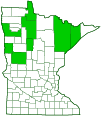Western tent caterpillar moth
(Malacosoma californica)
Conservation • Description • Habitat • Ecology • Distribution • Taxonomy
| Hodges # | 7702 |
|
|||
Conservation Status |
|||||
| IUCN Red List | not listed |
||||
| NatureServe | N5 - Secure |
||||
| Minnesota | not listed |
||||
Description |
Western tent caterpillar moth is common in western United States and western Canada, less common from Manitoba to Quebec. Isolated populations have been found in northern Minnesota, New Hampshire, and New York. Adults have a wingspan of 1⅜″ to 2″ (35 to 50 mm). Males are highly variable in color. The may be almost entirely light, mostly light but with dark shading in the median area, or entirely dark. The forewings are usually medium-dark reddish-brown. There are two smooth lines: the antemedial line (AM line), between the basal and median areas; and the postmedial line (PM line), that separates the median area from the postmedial area. Aside from two white patches on the fringe, the forewings are otherwise unmarked. On light males, the AM and PM lines are dark, on dark males they are light. The female is light reddish tan and not as variable in color. The hindwings of both sexes are entirely reddish-brown with a faint median band. The mature caterpillar is 1¾″ to 2″ long and highly variable in color. Most are pale blue. There is a broad black stripe on the upper middle (middorsal stripe) that has yellow and orange speckling. The speckling may be sparse or dense. In the center of the stripe on each abdominal segment there is a thin blue longitudinal line that does not quite reach the segment ends. The ground color is sometimes dark and the speckling coalesces into large reddish-orange spots. The body is covered with medium-length pale or orange hairs. |
Size |
Wingspan: 1⅜″ to 2″ (35 to 50 mm) |
Similar Species |
Habitat and Hosts |
|
Ecology |
Season |
One generation per year: Late July to early August |
Behavior |
|
Life Cycle |
First stage (instar) larvae overwinter in the egg. Eggs hatch in the spring within two weeks of the bud burst of its host species. Early instar caterpillars create a silken group nest and feed within the nest. Late instars feed alone outside the nest. The mature in 30 to 42 days, pupate, and emerge as adults in late July to early August. |
Larva Hosts |
Many trees and woody shrubs |
Adult Food |
|
Distribution |
||
|
Sources |
|
| 8/29/2025 | ||
Occurrence |
||
Common in the west, uncommon in Minnesota |
||
Taxonomy |
|
Order |
|
Superfamily |
Lasiocampoidea |
Family |
Lasiocampidae (lappet moths) |
Subfamily |
Lasiocampinae |
Tribe |
Lasiocampini |
Genus |
Malacosoma (tent caterpillar moths) |
Subfamily |
|
Subordinate Taxa |
|
western tent caterpillar moth (Malacosoma californica ambisimile) western tent caterpillar moth (Malacosoma californica californica) western tent caterpillar moth (Malacosoma californica fragilis) western tent caterpillar moth (Malacosoma californica lutescens) western tent caterpillar moth (Malacosoma californica pluviale) western tent caterpillar moth (Malacosoma californica recenseo) |
|
Synonyms |
|
Bombyx pseudoneustria Clisiocampa californica Clisiocampa thoracica Malacosoma californicum Malacosoma perlutea |
|
Common Names |
|
western tent caterpillar western tent caterpillar moth |
|
taxonomy2col |
|
Synonyms |
|
|
|
Common Names |
|
|
|
Glossary
Antemedial line
A thin line separating the basal area and the median area of the forewing of Lepidoptera.
Visitor Photos |
Share your photo of this insect. |
||
This button not working for you? |
||
|
||
|
MinnesotaSeasons.com Photos |
|

Slideshows |
|

Visitor Videos |
Share your video of this insect. |
||
This button not working for you? |
||
|
Other Videos |
Malacosoma californicum |
About
May 31, 2014 Western tent caterpillar are invading the Pacific Northwest! May2014 While opinions on tent caterpillars seem to vary, there is one thing no one seems to dispute — the little buggers are everywhere. Estimated by experts to number in the billions, they're wiggling and munching their way across communities throughout Western Washington, and Whidbey Island is no exception. Trees they plague, consuming leaves and coating branches like a moving bark, but nothing is out of reach: they cover mailboxes, parking lots, walls and even people can't seem to escape. |
Western Tent Caterpillars (Malacosoma californicum) |
About
Jun 10, 201 Western tent caterpillars (Malacosoma californicum) near Saint Mary Lake in the East Kootenays of British Columbia. |
Tent Caterpillars on the March |
About
Jun 26, 2012 The Western Tent Caterpillars are on the march. Colonizing new areas. Here they are crossing a bridge. They will have to negociate a busy road to get to new vegetation on the other side. ( Malacosoma californicum ) Vancouver, BC |
Western Tent Caterpillars on Tree Branch |
About
May 4, 2013 Close up video of western tent caterpillars in Bellingham, WA on May 4th, 2013. Malacosoma californicum, the western tent caterpillar, is a moth of the family Lasiocampidae. It is a tent caterpillar. It is found in the western part of the Nearctic ecozone. The wingspan is about 28 millimeters. |

Visitor Sightings |
Report a sighting of this insect. |
||
This button not working for you? |
||
|
|
MinnesotaSeasons.com Sightings |
|

|
Created: 10/14/2019 Last Updated: © MinnesotaSeasons.com. All rights reserved. |
